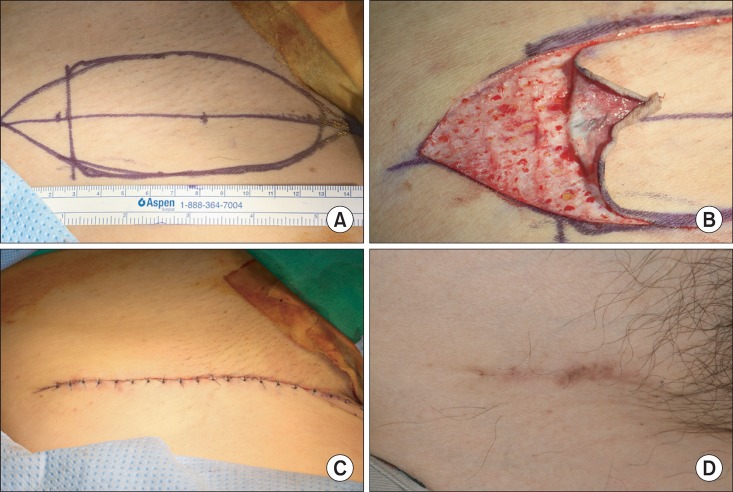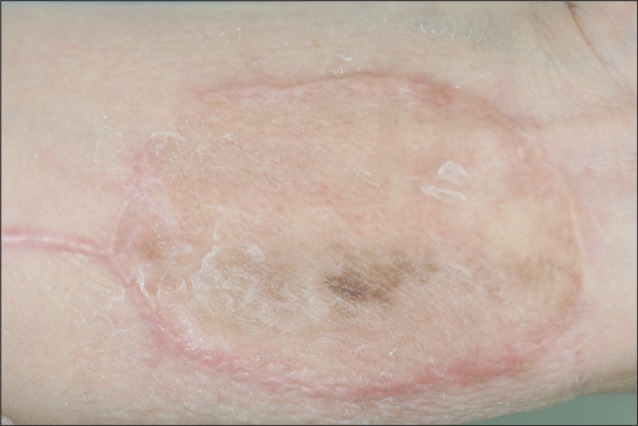J Korean Assoc Oral Maxillofac Surg.
2013 Feb;39(1):21-26. 10.5125/jkaoms.2013.39.1.21.
Full thickness skin grafts from the groin: donor site morbidity and graft survival rate from 50 cases
- Affiliations
-
- 1Department of Oral and Maxillofacial Surgery, College of Dentistry, Yonsei University, Seoul, Korea. cha8764@yuhs.ac
- 2Department of Oral Cancer Research Institute, College of Dentistry, Yonsei University, Seoul, Korea.
- KMID: 2189557
- DOI: http://doi.org/10.5125/jkaoms.2013.39.1.21
Abstract
OBJECTIVES
Full thickness skin grafts (FTSG) offer several advantages; they are esthetically superb, have less postoperative shrinkage, and offer minimal postoperative pain and scar formation at the donor site. As a donor site of FTSG, the groin offers a relatively large area of skin with high elasticity. The aim of this study was to evaluate FTSG from the groin for reconstruction in oral and maxillofacial surgery.
MATERIALS AND METHODS
In a retrospective study, 50 patients (27 males, 23 females) who received FTSG from the groin were evaluated for their operation records, clinical photography, and medical records.
RESULTS
The width of skin from the groin was distributed from 2-8 cm (mean: 5.1 cm) at the donor site, while the long axis length was distributed from 3-13 cm (mean: 7.4 cm). A high number of patients, 47 patients (94%) out of 50, showed good healing at the donor site. Wound impairment was seen in 3 patients (6%), minor wound dehiscence in 2 patients, and severe wound dehiscence in 1 patient. In the recipient site, delayed healing was observed in 2 patients (4%).
CONCLUSION
FTSG from the groin to repair soft tissue defects in reconstruction surgery is a good method due to the relatively big size of the graft, decreasing morbidity at the donor site, and higher graft survival rates.
Keyword
MeSH Terms
Figure
Reference
-
1. Taifour Suliman M. A simple method to facilitate full-thickness skin graft harvest. Burns. 2009; 35:87–88. PMID: 18703286.
Article2. Avery CM. Review of the radial free flap: is it still evolving, or is it facing extinction? Part one: soft-tissue radial flap. Br J Oral Maxillofac Surg. 2010; 48:245–252. PMID: 19837491.
Article3. Sidebottom AJ, Stevens L, Moore M, Magennis P, Devine JC, Brown JS, et al. Repair of the radial free flap donor site with full or partial thickness skin grafts. A prospective randomised controlled trial. Int J Oral Maxillofac Surg. 2000; 29:194–197. PMID: 10970081.
Article4. Lutz BS, Wei FC, Chang SC, Yang KH, Chen IH. Donor site morbidity after suprafascial elevation of the radial forearm flap: a prospective study in 95 consecutive cases. Plast Reconstr Surg. 1999; 103:132–137. PMID: 9915173.
Article5. Avery CM, Iqbal M, Orr R, Hayter JP. Repair of radial free flap donor site by full-thickness skin graft from inner arm. Br J Oral Maxillofac Surg. 2005; 43:161–165. PMID: 15749218.
Article6. Kim TB, Moe KS, Eisele DW, Orloff LA, Wang SJ. Full-thickness skin graft from the groin for coverage of the radial forearm free flap donor site. Am J Otolaryngol. 2007; 28:325–329. PMID: 17826534.
Article9. Shiba K, Iida Y, Numata T. Ipsilateral full-thickness forearm skin graft for covering the radial forearm flap donor site. Laryngoscope. 2003; 113:1043–1046. PMID: 12782819.
Article10. Juretic M, Car M, Zambelli M. The radial forearm free flap: our experience in solving donor site problems. J Craniomaxillofac Surg. 1992; 20:184–186. PMID: 1629369.
Article11. Hui KC, Zhang F, Lineaweaver WC. Z-plasty closure of the donor defect of the radial forearm free flap. J Reconstr Microsurg. 1999; 15:19–21. PMID: 10025526.
Article12. Bashir MA, Fung V, Kernohan MD, Ragbir M, Ahmed OA. "Z-plasty" modification of ulnar-based fasciocutaneous flap for closure of the radial forearm flap donor defect. Ann Plast Surg. 2010; 64:22–23. PMID: 20023451.
Article13. Squadrelli-Saraceno M, Compan A, Bimbi G, Gatto L, Riccio S, Colombo S. Autonomous reparative unit (ARU): a new concept of repairing free flap donor site with local full-thickness skin graft. Acta Otorhinolaryngol Ital. 2010; 30:40–46. PMID: 20559472.14. Ghanem TA, Wax MK. A novel split-thickness skin graft donor site: the radial skin paddle. Otolaryngol Head Neck Surg. 2009; 141:390–394. PMID: 19716019.
- Full Text Links
- Actions
-
Cited
- CITED
-
- Close
- Share
- Similar articles
-
- Compatibility of Ankle Skin as a Full Thickness Donor Site for Palmar Reconstruction
- Closure of radial forearm free flap donor-site defect with proportional local full-thickness skin graft: case series study of a new design
- Split-thickness Skin Graft on the Face from the Medial Arm Skin
- Long-Term Results of Palmar Ulnar Border Composite Graft after Postburn Hand Scar Contracture Release
- Dermis Graft for Wound Coverage: A Preliminary Report




